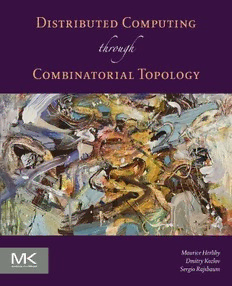Table Of ContentDistributed Computing
Through Combinatorial
Topology
This page is intentionally left blank
Distributed Computing
Through Combinatorial
Topology
Maurice Herlihy
Dmitry Kozlov
Sergio Rajsbaum
AMSTERDAM • BOSTON • HEIDELBERG • LONDON
NEW YORK • OXFORD • PARIS • SAN DIEGO
SAN FRANCISCO • SINGAPORE • SYDNEY • TOKYO
Morgan Kaufmann is an imprint of Elsevier
Acquiring Editor: Todd Green
Editorial Project Manager: Lindsay Lawrence
Project Manager: Punithavathy Govindaradjane
Designer: Maria Inês Cruz
Morgan Kaufmann is an imprint of Elsevier
225 Wyman Street, Waltham, MA 02451, USA
Copyright © 2014 Elsevier Inc. All rights reserved.
No part of this publication may be reproduced or transmitted in any form or by any means, electronic or mechanical,
including photocopying, recording, or any information storage and retrieval system, without permission in writing
from the publisher. Details on how to seek permission, further information about the Publisher’s permissions poli-
cies and our arrangements with organizations such as the Copyright Clearance Center and the Copyright Licensing
Agency, can be found at our website: www.elsevier.com/permissions.
This book and the individual contributions contained in it are protected under copyright by the Publisher (other
than as may be noted herein).
Notices
Knowledge and best practice in this field are constantly changing. As new research and experience broaden our
understanding, changes in research methods or professional practices, may become necessary. Practitioners and
researchers must always rely on their own experience and knowledge in evaluating and using any information or
methods described herein. In using such information or methods they should be mindful of their own safety and
the safety of others, including parties for whom they have a professional responsibility.
To the fullest extent of the law, neither the Publisher nor the authors, contributors, or editors, assume any liability
for any injury and/or damage to persons or property as a matter of products liability, negligence or otherwise, or
from any use or operation of any methods, products, instructions, or ideas contained in the material herein.
Library of Congress Cataloging-in-Publication Data
Herlihy, Maurice.
Distributed computing through combinatorial topology / Maurice Herlihy, Dmitry Kozlov, Sergio Rajsbaum.
pages cm
Includes bibliographical references and index.
ISBN 978-0-12-404578-1 (alk. paper)
1. Electronic data processing–Distributed processing–Mathematics.
2. Combinatorial topology. I. Kozlov, D. N. (Dmitrii Nikolaevich) II. Rajsbaum, Sergio. III. Title.
QA76.9.D5H473 2013
004'.36–dc23
2013038781
British Library Cataloguing-in-Publication Data
A catalogue record for this book is available from the British Library
ISBN: 978-0-12-404578-1
Printed and bound in the United States of America
14 15 16 17 18 10 9 8 7 6 5 4 3 2 1
For information on all MK publications
visit our website at www.mkp.com
For my parents, David and Patricia Herlihy, and for Liuba, David, and Anna.
To Esther, David, Judith, and Eva-Maria.
Dedicated to the memory of my grandparents, Itke and David, Anga and Sigmund,
and to the memory of my Ph.D. advisor, Shimon Even.
This page is intentionally left blank
CONTENTS
Acknowledgments ..................................................................................................................................xi
Preface .................................................................................................................................................xiii
PART I FUNDAMENTALS
CHAPTER 1 Introduction ���������������������������������������������������������������������������������3
1�1 Concurrency Everywhere ............................................................................................3
1�2 Distributed Computing ................................................................................................9
1�3 Two Classic Distributed Computing Problems ..........................................................12
1�4 Chapter Notes ............................................................................................................18
1�5 Exercises ....................................................................................................................19
CHAPTER 2 Two-Process Systems �����������������������������������������������������������������21
2�1 Elementary Graph Theory .........................................................................................22
2�2 Tasks ..........................................................................................................................25
2�3 Models of Computation .............................................................................................28
2�4 Approximate Agreement ............................................................................................33
2�5 Two-Process Task Solvability ....................................................................................36
2�6 Chapter Notes ............................................................................................................37
2�7 Exercises ....................................................................................................................38
CHAPTER 3 Elements of Combinatorial Topology ��������������������������������������������41
3�1 Basic Concepts ...........................................................................................................42
3�2 Simplicial Complexes ................................................................................................44
3�3 Standard Constructions ..............................................................................................47
3�4 Carrier Maps ..............................................................................................................50
3�5 Connectivity ...............................................................................................................53
3�6 Subdivisions ...............................................................................................................55
3�7 Simplicial and Continuous Approximations ..............................................................60
3�8 Chapter Notes ............................................................................................................64
3�9 Exercises ....................................................................................................................64
PART II COLORLESS TASKS
CHAPTER 4 Colorless Wait-Free Computation �������������������������������������������������69
4�1 Operational Model .....................................................................................................70
4�2 Combinatorial Model .................................................................................................78
vii
viii CONTENTS
4�3 The Computational Power of Wait-Free Colorless Immediate Snapshots .................88
4�4 Chapter Notes ............................................................................................................92
4�5 Exercises ....................................................................................................................93
CHAPTER 5 Solvability of Colorless Tasks in Different Models ������������������������97
5�1 Overview of Models ..................................................................................................98
5�2 t-Resilient Layered Snapshot Protocols .....................................................................99
5�3 Layered Snapshots with k-Set Agreement ...............................................................103
5�4 Adversaries ..............................................................................................................105
5�5 Message-Passing Protocols ......................................................................................108
5�6 Decidability ..............................................................................................................112
5�7 Chapter Notes ..........................................................................................................117
5�8 Exercises ..................................................................................................................118
CHAPTER 6 Byzantine-Resilient Colorless Computation ��������������������������������123
6�1 Byzantine Failures ...................................................................................................123
6�2 Byzantine Communication Abstractions .................................................................125
6�3 Byzantine Set Agreement ........................................................................................128
6�4 Byzantine Barycentric Agreement ...........................................................................128
6�5 Byzantine Task Solvability ......................................................................................129
6�6 Byzantine Shared Memory ......................................................................................131
6�7 Chapter Notes ..........................................................................................................132
6�8 Exercises ..................................................................................................................132
CHAPTER 7 Simulations and Reductions ������������������������������������������������������135
7�1 Motivation ................................................................................................................135
7�2 Combinatorial Setting ..............................................................................................137
7�3 Applications .............................................................................................................139
7�4 BG Simulation .........................................................................................................140
7�5 Conclusions ..............................................................................................................143
7�6 Chapter Notes ..........................................................................................................144
7�7 Exercises ..................................................................................................................145
PART III GENERAL TASKS
CHAPTER 8 Read-Write Protocols for General Tasks �������������������������������������149
8�1 Overview ..................................................................................................................149
8�2 Tasks ........................................................................................................................150
8�3 Examples of Tasks ...................................................................................................152
8�4 Protocols ..................................................................................................................158
CONTENTS ix
8�5 Chapter Notes ..........................................................................................................163
8�6 Exercises ..................................................................................................................164
CHAPTER 9 Manifold Protocols �������������������������������������������������������������������167
9�1 Manifold Protocols ..................................................................................................168
9�2 Layered Immediate Snapshot Protocols ..................................................................173
9�3 No Set Agreement from Manifold Protocols ...........................................................178
9�4 Set Agreement vs. Weak Symmetry Breaking .........................................................182
9�5 Chapter Notes ..........................................................................................................188
9�6 Exercises ..................................................................................................................189
CHAPTER 10 Connectivity �����������������������������������������������������������������������������191
10�1 Consensus and Path Connectivity ............................................................................191
10�2 Immediate Snapshot Model and Connectivity .........................................................193
10�3 k-Set Agreement and (k − 1)-Connectivity ..............................................................199
10�4 Immediate Snapshot Model and k-Connectivity ......................................................199
10�5 Chapter Notes ..........................................................................................................203
10�6 Exercises ..................................................................................................................204
CHAPTER 11 Wait-Free Computability for General Tasks ���������������������������������205
11�1 Inherently Colored Tasks: The Hourglass Task .......................................................205
11�2 Solvability for Colored Tasks ..................................................................................208
11�3 Algorithm Implies Map ...........................................................................................212
11�4 Map Implies Algorithm ............................................................................................212
11�5 A Sufficient Topological Condition .........................................................................222
11�6 Chapter Notes ..........................................................................................................227
11�7 Exercises ..................................................................................................................227
PART IV ADVANCED TOPICS
CHAPTER 12 Renaming and Oriented Manifolds ���������������������������������������������231
12�1 An Upper Bound: Renaming with 2n + 1 Names ....................................................232
12�2 Weak Symmetry Breaking .......................................................................................236
12�3 The Index Lemma ....................................................................................................237
12�4 Binary Colorings ......................................................................................................240
12�5 A Lower Bound for 2n-Renaming ..........................................................................242
12�6 Chapter Notes ..........................................................................................................244
12�7 Exercises ..................................................................................................................244

